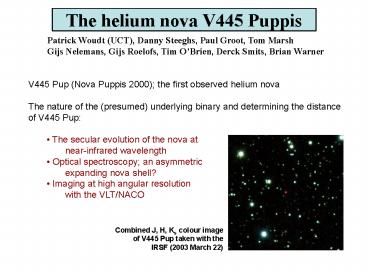The helium nova V445 Puppis
1 / 10
Title:
The helium nova V445 Puppis
Description:
Patrick Woudt (UCT), Danny Steeghs, Paul Groot, Tom Marsh ... V445 Pup (Nova Puppis 2000); the first observed helium nova ... Last nova of the previous millenium: ... –
Number of Views:93
Avg rating:3.0/5.0
Title: The helium nova V445 Puppis
1
The helium nova V445 Puppis
Patrick Woudt (UCT), Danny Steeghs, Paul Groot,
Tom Marsh Gijs Nelemans, Gijs Roelofs, Tim
OBrien, Derck Smits, Brian Warner
- V445 Pup (Nova Puppis 2000) the first observed
helium nova - The nature of the (presumed) underlying binary
and determining the distance - of V445 Pup
- The secular evolution of the nova at
- near-infrared wavelength
- Optical spectroscopy an asymmetric
- expanding nova shell?
- Imaging at high angular resolution
- with the VLT/NACO
Combined J, H, Ks colour image of V445 Pup taken
with the IRSF (2003 March 22)
2
V445 Pup (Nova Puppis 2000) the first observed
helium nova
- Last nova of the previous millenium
- Reported 2000 Dec 30 (Kato Kanatsu 2000), but
first outburst - measurement 2000 Nov 23
- Proposed as the first observed helium nova (Kato
Hachisu 2003 Ashok Banerjee 2003). Various
unique aspects - Hydrogen-deficient (Wagner et al. 2001)
- Enriched in carbon and helium (e.g. Ashok
Banerjee 2003) - The initially formed optically thin dust shell
has developed in an optically thick shell
(Henden et al. 2001) - Shell still obscures the nova (4-5 years later)
- One of a kind!
- From modelling of the optical light curve, Kato
Hachisu (2003) deduced the following
(model-dependent) parameters - Mass of the primary (M1) gt 1.33 Msun
- dM/dt is several times 10-7 Msun/yr
- nova recurrence time (tr) is 70 yr
- M1 and tr in their models depend sensitively on
the assumed distance - d 640 pc (1.33 Msun and 61 yr) d 700 pc
(1.35 Msun and 84 yr)
3
V445 Pup (Nova Puppis 2000), the first observed
helium nova
- Short recurrence time between nova outbursts and
weak photospheric wind ? white dwarf continuously
growing in mass ? either progenitor of SN Ia, or
end up via accretion-induced collapse as a
neutron star. - Nature of the underlying binary still unknown
- AM CVn at short Porb (high dM/dt) MV 5 9
mag - CV with a helium donor (Iben Tutukov 1991) Mv
-1 mag - Hydrogen accretor with very high dM/dt Mv -2
to 3 mag - ?
4
V445 Pup in outburst (optical). Figure from Ashok
Banerjee (2003).
V445 Pup monitoring campaign on the Japanese
1.4-m InfraRed Survey Telescope 22 March 2002 -
present
5
The optical spectrum of V445 Pup
Taken with the 6.5-m Magellan telescope and the
imaging spectrograph (IMACS) on 2003 December 17
(3 years after outburst).
Spectral lines HeI, OI, OII and OIII High
temperatures 20000 K (OIII 4363Å, OII
7320/7330Å) High reddening! I(3727Å) vs.
I(7320/7330Å)
6
The optical spectrum of V445 Pup (line
diagnostics)
The main velocity-components -1570 km/s, -850
km/s and 750 km/s
7
The optical spectrum of V445 Pup (line
diagnostics)
Is there any evidence of hydrogen?
8
V445 Pup spatially resolved
Taken with the VLT and the NAOS/CONICA adaptive
optics camera (in the Ks band) on 2005 March 25.
Second epoch due 2005 September. Scale
0.027/pixel, FWHM 0.1
Distance upper limit diameter 2.1 ? D lt
1.5 kpc ? mV MV lt 10.9 mag (combined with AV
lt 0.7 mag) ? MV gt 3.3 mag
9
Detailed dynamical modelling of the nova
shell Necessary for accurate expansion
parallax measurement. Integral Field Unit
Spectroscopy 2006 January 2 nights on Magellan
IFU Follow-up adaptive optics observations
with SINFONI
HR Del (in OIII).
VLT (NAOS/CONICA) Ks band image of V445 Pup.
10
- V445 Puppis (current observational overview)
- Adaptive optics imaging clear estimate of the
size of the shell - Integral Field Unit spectroscopy (2 nights in
2006 January) - Detailed dynamical modelling
- Current (conservative) distance
- constraint d lt 1.5 kpc
- MV fainter than 3.3 mag (a very
- conservative estimate)
- Nature of the underlying binary still unknown
- AM CVn at short Porb (high dM/dt) MV 5 9
mag - CV with a helium donor Mv -1 mag
- Hydrogen accretor with very high dM/dt Mv -2
to 3 mag - ?
- Scheduled observations with ULTRACAM (2005
November) to search for periodicities.































